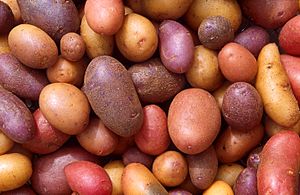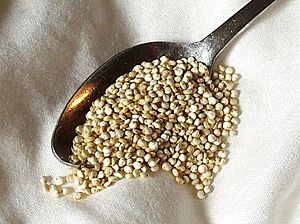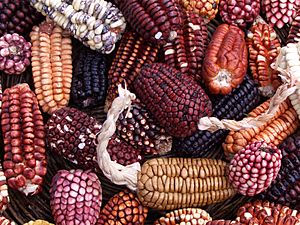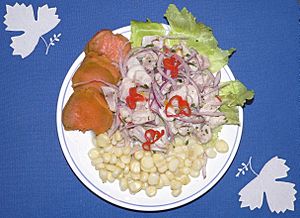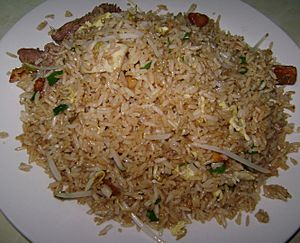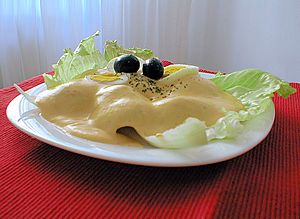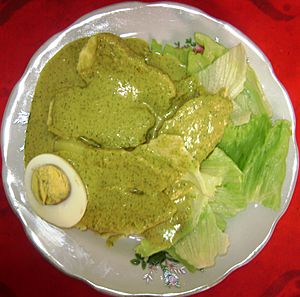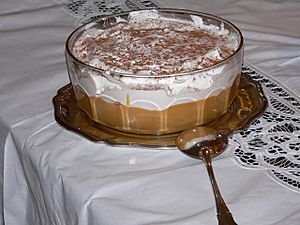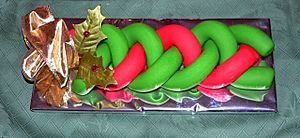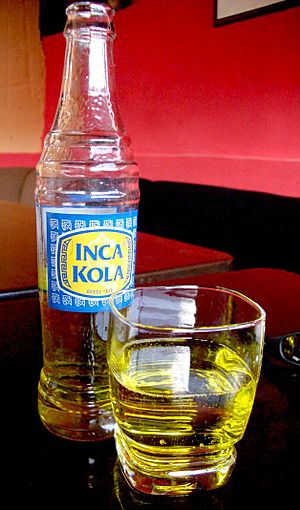Peruvian cuisine facts for kids
Peruvian food is a super interesting mix of different cultures! It combines local ingredients and cooking styles from the Inca and other native groups. Over time, people from Europe (Spain, Italy), Asia (Japan, China), and Africa brought their own recipes. When they arrived in Peru, they used the ingredients they could find there, creating unique new dishes.
The main foods in traditional Peruvian cooking are corn, potatoes, and other root vegetables. They also use special grains like quinoa, kañiwa, and kiwicha. Beans and lupins are also important. The Spanish later brought new foods like rice, wheat, and meats such as beef, pork, and chicken.
Many old Peruvian foods, like quinoa and chili peppers, have become popular again recently. People are excited about Peru's native ingredients and cooking methods. A famous chef named Gaston Acurio has helped show the world how amazing these local foods are. The potato is super important in Peruvian food because Peru has the most types of potatoes in the world!
A food expert from the US, Eric Asimov, said that Peruvian food is one of the most important cuisines globally. He called it a great example of "fusion cuisine" because of its long history of mixing cultures.
Contents
Amazing Peruvian Crops
Peru is a special place for many crops around the world. It has a huge variety of plants:
- Potatoes: Many kinds of potatoes come from the Andes mountains in Peru. Over 99% of all potatoes grown today come from one type found in Peru. These have grown into thousands of varieties, all different in size, shape, and color!
- Quinoa: This is sometimes called "Indian rice." Peru has three types of it.
- Kaniwa: Another grain similar to quinoa.
- Tarwi: A bean-like plant from the Andes, similar to a lupin bean.
- Lima bean: A type of bean that started in Peru.
- Maca: A root vegetable.
- Oca, Mashua, Ulluco: These are all root vegetables that look a bit like potatoes.
- Caigua: A vegetable that tastes a bit like a cucumber.
- Chili Peppers: Peru has many unique chili peppers like ají amarillo, ají limón, rocoto chile, ají panca, and ají mochero/limo.
- Fruits: Peru has about 20 native fruits used in cooking or eaten fresh.
The sweet potato also comes from the Americas and has been grown for at least 5,000 years. You can find different types of sweet potatoes in Peruvian markets. Some are orange and sweet, while others are purple and less sweet.
Many fruits from the Andes region (like Peru and Bolivia) include lucuma, camu camu, prickly pear, cape gooseberry, cherimoya, and papaya. Even yacon, which is a root, is often eaten like a fruit.
When the Spanish came to Peru, they took many foods back to Europe that became important all over the world.
- Potatoes: They were first seen as animal food in Europe. But after a French chemist, Antoine-Augustin Parmentier, served them at fancy dinners, people realized they were delicious!
- Beans: Several types of common beans, including the lima bean, are from Latin America.
The Spanish also brought back different kinds of chili peppers, potatoes, tomatoes, and maize (corn) that were native to Peru.
- Peppers: Peruvian ají peppers are special and mostly found in the Andes.
- Maize: Peruvian corn is sweet and has large kernels, but it's not widely eaten outside Peru.
- Tomatoes: The wild ancestor of the tomato comes from western South America, including parts of Peru.
Many foods from Spain are now common in Peru, like wheat, rice, lentils, chickpeas, garlic, onions, beef, chicken, and many spices.
Growing Ancient Plants
For a long time, Peruvian cooking mostly followed Spanish styles. Traditional native plants were seen as "peasant food." But since the 1970s, people have worked hard to bring these amazing native plants back into the spotlight.
Some plants grown by ancient Peruvian societies are now being rediscovered and studied by scientists. Because of Peru's unique land and climate, some of these plants could be very important for future food. For example, quinoa and kañiwa are great sources of protein. Scientists are also studying root vegetables like maca and grains like kiwicha.
Since 1985, NASA has even used quinoa, kiwicha, and maca for astronaut meals! Famous people like Oprah Winfrey and NASA have promoted these Andean ingredients as "superfoods." This has helped farmers earn more money and made Peruvian culture more known around the world. However, it has also made these ingredients more expensive for native Peruvians.
These traditional foods help many Peruvians get good nutrition, even if they don't have much money. When these foods were ignored in the past, people's nutrition suffered.
Peruvian food often uses ají pepper for flavor and color, but it's not always super spicy. Rice is also a common side dish. Different regions in Peru have their own unique ways of preparing food.
Food Across Peru's Regions
Peru is a country with many different cultures and 28 types of climates! This mix of cultures and climates means that each city and region has its own special dishes.
Coastal Delights
The Pacific Ocean is a huge source of seafood for Peru. Peru is one of the top countries for fishing! Its waters are full of fish and other sea creatures, many found only in Peru. Rivers like the Amazon River and Lake Titicaca also provide many freshwater foods.
Each coastal area uses the seafood and plants available in its waters to create unique dishes.
Ceviche is a great example. It's a South American dish of raw fish or seafood marinated in citrus juice. You'll find it in almost all Peruvian coastal restaurants, usually served with sweet potato (camote). In Peru, it's often spelled "cebiche" and is a very popular dish. It's made with Peruvian chili peppers, onions, and sour lime juice. Before the Spanish arrived, people used fermented fruit juice to marinate seafood. When the Spanish brought citrus fruits, they started using those. Ceviche is usually spicy and served with raw onions, boiled sweet potatoes, and toasted corn (cancha).
Unlike ceviche from Mexico or Ecuador, Peruvian ceviche doesn't have tomatoes. Another popular part of ceviche is Leche de tigre (tiger's milk), which is the flavorful marinade itself.
Chupe de camarones (shrimp soup) is another favorite coastal dish. It's a thick soup made with freshwater shrimp, potatoes, milk, and chili pepper. It's especially popular in restaurants that specialize in food from Arequipa.
Lima and Trujillo are big cities that have welcomed many immigrants. This has added unique dishes to their local food. Since the mid-1900s, many people from rural areas have moved to Lima, bringing their ingredients and cooking styles with them.
Creole cuisine is the most common in Lima. The city also has many international restaurants, with Italian and Chinese food being very popular. Chinese-Peruvian food is called chifa. Arroz Chaufa, Peruvian fried rice, is a popular chifa dish. It's made with peppers, onions, garlic, soy sauce, eggs, chicken, and other spices. It's Peru’s version of Chinese fried rice.
Peruvian bakeries are also very popular. People often line up for fresh white bread in the mornings and afternoons. Most Peruvian bread is made with added fats like lard.
Anticuchos are grilled skewers made from beef heart. They are marinated in Peruvian spices and often served with boiled potato or corn. You can find them from street vendors or in restaurants.
Street vendors also sell tamales: boiled corn with meat or cheese, wrapped in a banana leaf. They are similar to humitas, which are corn mixed with spices and filled with pork and olives, wrapped in corn husks. Tamales are a common breakfast food, often served with lime and Salsa Criolla (a mix of sliced red onion, ají peppers, cilantro, and lime juice).
Papa a la Huancaina (Huancayo-style potatoes) is another favorite. It's sliced boiled potatoes served on lettuce with a creamy, slightly spicy cheese sauce and olives. It's cheap to make but has complex flavors, making it popular with everyone. The dish gets its name from the city of Huancayo.
Tacu-tacu: A mix of beans and rice, often served with a fried egg, steak, and Salsa Criolla.
Papa rellena (stuffed potato): Mashed potatoes filled with ground meat, eggs, olives, and spices, then deep-fried.
Pollo a la Brasa (Peruvian rotisserie chicken) is one of the most eaten foods in Peru. The chicken is marinated in Peruvian spices and roasted. This dish started in Lima in the 1950s. It comes with French fries, salad, and different sauces like Peruvian mayonnaise and chili sauces. Famous restaurants for Pollo a la Brasa include Hikari, Norky's, and Pardo's.
Sancochado is a hearty beef and vegetable soup with yuca (cassava) and potatoes.
Lomo Saltado is a popular stir-fried dish. Sliced beef is cooked with garlic, cumin, tomato, and onion, then mixed with French fries, coriander, and soy sauce. It's served with white rice. This dish shows the influence of Chinese cooking in Peru.
Arroz con pollo, or rice with chicken, is loved for its rich flavor.
Chupe de pescado or fish soup is popular in Lima and along the coast.
Lima butter bean salad is made with cooked Lima butter beans (called pallares), mixed with onion, tomato, green ají, lime juice, and oil. Lima butter beans have been part of Peruvian food for at least 6,000 years.
Butifarras are sandwiches with "Peruvian ham," sliced onions, chili peppers, lime, and oil, served in a white bread roll.
Causa is a mashed yellow potato dish mixed with lime, onion, chili, and oil. Sometimes it has avocado, chicken, tuna, or seafood. It's usually served cold with hard-boiled eggs and olives.
Carapulcra is a tasty stew with pork, chicken, dried potatoes, red chilis, and peanuts.
Empanadas (meat turnovers) came from Spain and were changed in Peru. They are filled with chicken, beef, or cheese, and often have olives, hard-boiled eggs, and raisins.
Ají de gallina (Peruvian creamed chicken) is chicken strips in a creamy, spicy yellow sauce made with ají amarillo (yellow chilis), cheese, milk, and bread.
Escabeche criollo (pickled fish) is a dish where fish (or duck or chicken) is cooked with lots of vinegar, onions, and spices.
Cau cau is a stew made with mondongo or tripe (stomach lining), served with rice. There are different versions, including a Creole style and an Italian-Peruvian style.
Chicharrones are salted pork pieces deep-fried in their own fat. You can also find deep-fried squid and other seafood called chicharrones. They can be eaten any time of day, even for breakfast.
The food on the northern coast is different because of its native Indian, Spanish, and African influences, as well as the warmer climate.
Northern dishes include: Seco de Cabrito (goat stew): Made with goat (or lamb, chicken, or beef) marinated in chicha de jora (corn beer) and spices like cilantro and garlic. This is popular in Cajamarca and Lambayeque.
Cebiche de Conchas Negras (ceviche with black shells): A dish from Piura and Tumbes that uses black clams and toasted corn.
Andes Mountain Food
In the Andes mountains, people still eat traditional foods like corn, potatoes, and other root vegetables. Meat comes from native animals like alpacas and guinea pigs, and also from animals brought by the Spanish, like sheep, cattle, and pigs.
In the past, fancy dishes were saved for celebrations. But now, people in cities eat these festive dishes every day.
The pachamanca is a special Peruvian dish. It's cooked underground on hot stones with different meats (like pork and beef), herbs, and vegetables. Because it takes a lot of effort, it's usually made for celebrations.
The main freshwater fish in Andean cooking is trout, often raised in local farms.
Cuy: Guinea pig is often served whole, or its meat can be used in other dishes.
Cuy chactado: A popular dish in the highlands is fried guinea pig.
Olluquito con charqui is another traditional Andean dish. Olluco is a yellow root vegetable that looks like a small potato but has a crunchy texture. Charqui is a way of preserving meat by salting and drying it (this is where the English word "jerky" comes from). The dish is a stew of diced ollucos with pieces of charqui (traditionally alpaca or llama, but now often sheep), served with white rice.
Rocoto relleno: An Arequipa dish made from stuffed rocoto chilis. Rocotos are very spicy chilis. They are filled with spiced beef or pork, onions, olives, and egg white, then baked with potatoes and covered with cheese and milk.
Tocosh or Togosh is a traditional food made from fermented potato pulp.
Puka Pikanti: An Ayacucho dish made from white potatoes, beets, yellow chili pepper, mint, and peanuts.
In Peruvian restaurants, steak is often served with rice instead of fries.
Amazon Jungle Cuisine
Amazonian cuisine uses foods found in the Amazon rainforest. Many animals are hunted for food, like the paiche (one of the world's largest freshwater fish). Other fish like gamitana and piranha are used in soups ("timbuche") or grilled in vegetables ("patarashca"). Hunting turtles is against the law in Peru, so turtle dishes are rare and expensive. Other jungle animals eaten include majas, sajino, and agouti.
Some fruits from the Peruvian jungle include camu camu, which has 40 times more vitamin C than a kiwifruit. You can also find mangoes, pineapples, cherimoyas, and guanabanas.
Juane is rice seasoned with turmeric and chicken, wrapped in bijao leaves.
Chapo is a drink made from sweet plantain.
Other Regional Dishes
Chalona or Charqui is cured, dried meat, originally from alpaca. It's also eaten in Bolivia and was eaten by native people in Peru before the Spanish arrived. Today, lamb is often used instead of alpaca. It's an ingredient in many dishes from the Puno, Cusco, and Arequipa regions.
Chairo: A traditional soup from the Puno and Arequipa regions. It comes from the Collan Indians in Bolivia and southern Peru. The soup has black chuño (dried potato), red chili pepper, sweet potatoes, sheep tripe, and chalona.
Ocopa: This dish is similar to Papa a la Huancaina. It has boiled and sliced yellow potatoes covered with a sauce made from ají (chili pepper), the Peruvian herb huacatay (which gives it a bright green color), ground peanuts, and fresh cheese. It's served with lettuce, boiled eggs, and olives.
Copús is a famous dish from Piura. It includes ripe fried bananas, sweet potatoes (camotes), and seasoned hen, turkey, goat, and mutton. The meat is cooked in an underground oven.
Yuca chupe or cassava soup is another way Peruvians enjoy cassava.
Sangrecita: A dish of cooked chicken blood seasoned with garlic, onion, chili, and herbs, often served with potatoes or cassava.
Crema de tarwi (tarwi soup): Tarwi is a vegetable from the mountains of Bolivia, Ecuador, and Peru. It's used in many Peruvian dishes, including soups and even a type of ceviche. Tarwi has more protein than soy. In ancient times, it was a very important part of the diet.
Chifa - Peruvian Chinese Food
Chifa is the Peruvian name for Peruvian-Chinese food or a Peruvian-Chinese restaurant. The word comes from the Mandarin Chinese words "chi fan," meaning "to eat rice." Because some Chinese ingredients were hard to find in Peru, Chinese cooks changed their recipes and added Peruvian elements. Chifa became so popular that it's now a big part of Peruvian food!
Sweet Treats and Desserts
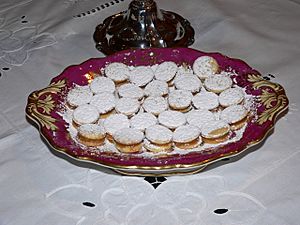
Alfajores: These cookies are found in many countries that used to be Spanish colonies. The original Spanish recipes were changed in Peru because some ingredients were expensive or hard to find. The basic recipe uses flour, margarine, and powdered sugar. Alfajores usually have two or more layers of this cookie, filled with manjar blanco (a sweet, creamy filling made from milk and sugar).
Turrones (or nougat) is another dessert that came from Spain. The Peruvian version, especially Turrón de Doña Pepa, is an anise and honey nougat. It's traditionally eaten during the Señor de los Milagros (Lord of Miracles) religious parade in October.
The fruit lúcuma is almost only found in the Andes region. Lúcuma juice, ice cream, and shakes are very popular in Peru. Lúcuma ice cream is so unique that it's hard to find outside of Peru.
Arroz con leche (rice pudding): This dessert also came from Spain and is common in Peru. It's made with cooked rice, cinnamon, raisins, and milk. It's often eaten with Peruvian Mazamorra (a jelly-like clove-flavored dessert).
Helados (ice cream): The most common ice cream flavors in Peru are lucuma, chocolate, vanilla, and strawberry. Lucuma is so popular that it's the third most popular flavor after vanilla and chocolate!
Mazamorra morada: This is a jelly-like dessert flavored with cloves. It gets its purple color from one of its main ingredients: purple corn. This special purple corn only grows in Peru. When the corn water cools, chopped fruit, lime, and sugar are added. This mixture is also served as a drink called "chicha morada".
Picarones: These are sweet, ring-shaped fried dough made with pumpkin. They are often served with a molasses syrup. Picarones were created during the colonial period to replace a Spanish dessert that was too expensive to make. Peruvian Picarones are made from squash or pumpkin dough and sweetened with chancaca, which is raw cane sugar melted into a syrup.
Tejas: Another modified Spanish dessert. The Peruvian version is filled with manjar blanco and covered with a fondant-like shell. Some are also made with a chocolate shell (chocoteja).
King Kong: This is a large cookie sandwich made of cookies filled with milk candy, pineapple jam, and sometimes peanuts. It's a special part of the culture in the Lambayeque Region.
Suspiro a la Limeña: This dessert is also influenced by Spain. It has a bottom layer of dulce de leche (a sweet caramel-like sauce) mixed with egg yolks. The top layer is a meringue made with port wine. This classic dessert is said to have been named by a Peruvian poet who said it was "soft and sweet, like the sigh of a woman" from Lima (a Limeña).
Panetón: A type of sweet bread with dried fruit. It's usually eaten for breakfast around Christmas with hot chocolate.
Flan de leche is also a very popular dessert.
Drinks
Soft Drinks
The most common soft drinks in Peru are:
- Chicha morada: A drink made from boiled purple corn, cloves, sugar, cinnamon, and ice. It tastes a bit like old-fashioned clove candy.
- Inca Kola: A yellow soda flavored with lemon verbena. It's a cultural icon in Peru and is very sweet. Inca Kola is so popular that it even sold more than Coca-Cola in Peru for a while! This is partly because Peruvians are very proud of their local products.
- Kola Inglesa: A red, cherry-flavored soda.
- Kola Escocesa: A purple soda traditional in the city of Arequipa.
Less common drinks include:
- Refresco de camu camu: Refrescos are juices mixed with water and sugar. Camu camu is a unique flavor.
- Té de uña de gato: A tea made from a plant called cat's claw, believed to have healing properties.
Traditional Drinks
Pisco, a type of brandy, is the national drink of Peru. It's a distilled beverage made from grapes. Pisco Sour is a famous cocktail made with pisco, lime juice, egg white, and syrup.
Beer is popular in Peru. Local brands include Pilsen Callao and Cristal.
Chicha de jora is another well-known drink, made from different types of fermented maize and herbs. It's mostly found in the Andes region.
History of Peruvian Food
Peru is an incredibly diverse country, and its food shows this! It has 84 of the world's 104 climate zones, from snowy mountains to tropical forests. This means fruits and vegetables can grow all year. The cold Humboldt Current in the Pacific Ocean also brings a huge variety of fish and shellfish.
Immigration and the arrival of people from Africa also shaped Peru's food history. In the 1500s, the Spanish brought people from Africa to Peru. Many Afro-Peruvian women worked in homes or sold food. Their influence helped create Peru's national food heritage.
A woman named Doña Josefa Marmanillo, an Afro-Peruvian living in Lima, created the dessert Turrón de Doña Pepa. She became paralyzed in her arms but was healed after visiting the Señor de los Milagros (Lord of Miracles) procession. To show her thanks, she created this special dessert. It's still eaten every October during the Lord of Miracles celebration, which is one of the world's largest Catholic events. Another dessert eaten during this time is mazamorra morada (purple pudding).
Food is very important to Peru's identity. A cultural expert, M. Cristina Alcalde, said that food is now a bigger marketing feature for Peru than even the famous Machu Picchu! Many Peruvians who live abroad say that eating Peruvian dishes makes them feel at home. Popular dishes like ceviche, causa, ají de gallina, and lomo saltado are a source of great pride for Peruvians.
See also
 In Spanish: Gastronomía del Perú para niños
In Spanish: Gastronomía del Perú para niños


